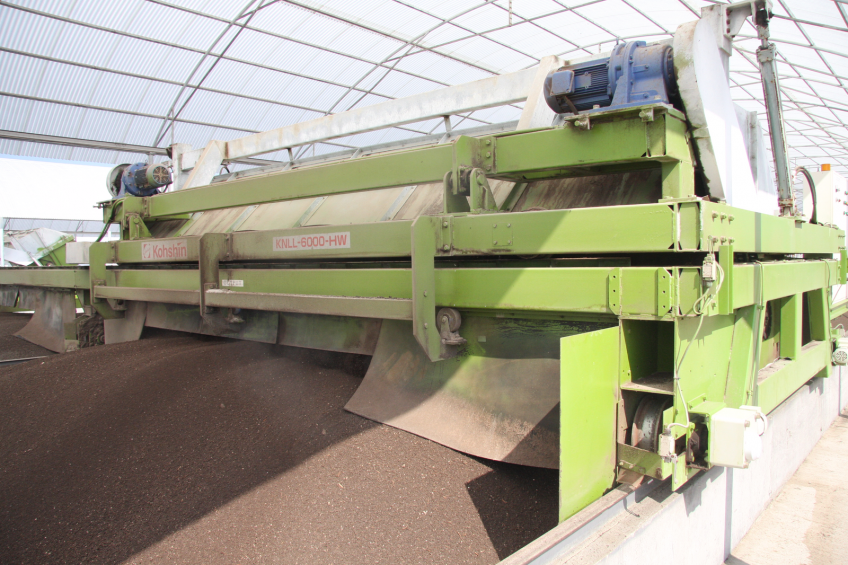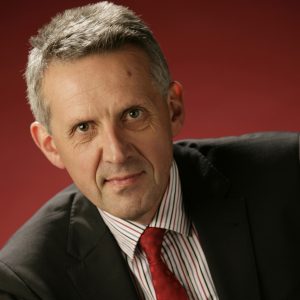Manure composting serves two goals

Poultry manure is often seen as a threat to the environment. ?But when treated and processed properly, it can also be used as a valuable organic fertiliser. A prime example is Proan in Mexico. Currently they are using 20 Kohshin composting machines. And 24 more will be in operation soon.
By Ad Bal
Poultry production goes hand in hand with producing manure. That’s the simple reality of today’s modern large scale livestock farming methods. Logically this can be seen as a threat to the environment, but also as a valuable source of fertiliser in crop production. This demands proper manure treatment however. A supplier of such treatment equipment is Kohshin from Japan. Their manure fermentation machines are in use all-over the world. Such as at the premises of the Proan layer farms in San Juan de los Lagos, Mexico. With around 30 million layers in production, Proan is indeed a big supplier of table eggs in Mexico and to many other countries around the world. As a result, adequate manure treatment is essential for such a large egg producer.
44 machines
The idea behind the fermentation of poultry manure is based on adequate aeration at the right temperature and humidity. “Various suppliers of machines for this purpose are available,” says Javier Pérez Martin of Proan. Javier is responsible for the ‘Bioagrofert’ composting division of the company. “We have found that the Kohshin technology best fits with our expectations,” he continues. “We are currently using both the so-called ‘windrow’ system, as well as the Kohshin system. With the windrow system, manure is put in rows at the field. A trailed windrowing machine is pulled over these rows in order to get the manure mixed.
Currently, Proan is using 20 Kohshin machines, says Javier Pérez Martin of Proan. 24 more machines will be in operation soon.
The Kohshin system is based on machines at a fixed place which process the manure very intensively. This leads to the best quality natural fertiliser and that’s what we are aiming for. It is the objective of Proan to, in each respect, supply the best possible quality product. That also demands the use of high quality machines, such as Kohshin’s equipment. Currently there are 20 machines in operation. We are so satisfied with the quality of the end product, that as a consequence, we have decided to install 24 more of such machines. These will soon be in operation.”
Basic conditions
The technology of the Kohshin machines is based on a rotating harrow with bladed knives, which through its movement mixes and intensively puts the manure upside down. “It’s important to have three basic conditions under control,” explains Javier. “These are: a permanent temperature of in between 55-60°C, humidity of 50% and an oxygen percentage of 16-18%. In the Kohshin system, these three conditions are easy to manage in order to let aerobic bacteria do the fermentation work. Additional blowers can provide fresh air and thus oxygen, whereas water can be added through hoses or sprinklers. Through intensive mixing of the manure, the end product is of an even and permanent composition.”
Slowly moving
A Kohshin machine is built on a kind of framework which slowly moves forward on a rail construction. These rails are mounted on concrete walls, two of which run parallel, and one is centrally located on a concrete floor under a covered roof. The walls are about one metre high. The entire width of the floor is 12 metres and through the central wall partition, two floors of six metres wide each, are created (see Figure 1).
Once the fresh manure is put and distributed evenly on the concrete floors of the pits, the fermentation process can get started. For this purpose, the machine is slowly moving forward at a speed of 0.6-1.7 m/min, thus agitating and mixing (churning) the manure.
Once the machine has reached the end of the pit after a full working shift, the working part lifts up and the entire machine moves back to where it started, without churning. Then at the starting position the moving part slides to the pit at the other side of the central wall and starts operating again, processing a new batch of manure. Once it has reached the end of this floor, it moves back again and the process continues. Both the rotor as well as the machine itself, are powered by means of electric motors. Kohshin supplies a full range of models in a wide choice of capacities for various purposes. Proan is using two models with a capacity of 60 and 95 cubic metres respectively.
Organic fertiliser
After 28 days the process is finished. The manure is then turned into ready fertiliser which is taken out by a shovel. Either it is then put on a truck to directly be taken to and distributed on agricultural land, or put in bags for use in smaller quantities.
Thus a large quantity of poultry manure at the Proan premises has with the help of Kohshin machines turned into organic fertiliser.
Mission accomplished: minimising pollution and producing a good quality natural product. WPAfter 28 days, the finished product is taken out of the pit by means of a shovel.The finished organic fertiliser is sold under the Bioagrofert Kohshin 38 brand name, either in bulk or in bags. Bioagrofert hands out samples in small bags.The technology is based on a rotating harrow with bladed knives.
Large company
Proan is a privately owned company and with about 30 million layers it is the biggest egg
producer in Mexico and Latin America. The company produces table eggs for the domestic market, as well as for export to many countries across the globe. Apart from producing table eggs, Proan also has its own egg processing facilities which produces both liquid as well as powdered egg products. For packing their table eggs, they produce their own consumer size plastic egg boxes from recycled material, as well as carton trays and cardboard boxes.
In addition Proan keeps about 52,000 sows and supplies 26,000 slaughtering pigs per week. They also have over 5,500 head of dairy cattle including a milk processing plant. Of course all animal feed is produced in their own feed plant. Last but not least Proan owns a bakery which produces all kinds of frozen bread and a wide variety of frozen bakery products.
Steps of processing
1 – Collecting raw manure
2 – Adjusting moisture to in between 60-70%
3 – Feed manure into the machine
4 – Start operation
5 – Machine moves manure 2.3 m per rotation (model KNLL-6000HW)
6 – Bacteria start activating and decomposing manure
7 – Due to bacteria activation, heat reaches 50-70°C
8 – Harmful bacteria and seeds are inactivated
9 – Composting process continues for 25-30 days
10 – Final product ready for packaging and distribution
Crop growing and consumer market
Bioagrofert is a separate division of Proan. The purpose of this company is to produce and market fermented poultry manure to customers in the San Juan area. Currently Bioagrofert supplies processed manure as natural fertiliser to maize producers. For that purpose it is packed in bags of 25 kg each and applied in the row at two tonnes per ha. Other crops like grass, alfalfa, wheat and other full field crops will receive about 3-4 tonnes per ha. The composted manure is certified by the Organic Materials Review Institute (OMRI) in the USA. This organisation is also authorised to certify organic material which is sold to consumers. This is the next step of Bioagrofert: accessing the consumer market through retail channels like supermarkets and gardening centres. The organic fertiliser will thus be sold in small sized bags and used for gardening purposes.
[Source: World Poultry magazine Vol 30 nr 3, 2014]













